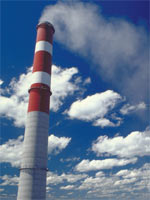Guidelines and Codes of Practice
 New Source Emission Guidelines for Thermal Electricity Generation
New Source Emission Guidelines for Thermal Electricity Generation
New Source Emission Guidelines for Thermal Electricity Generation have been published under the Canadian Environmental Protection Act, 1999 (CEPA 1999). These CEPA 1999 Guidelines are intended to provide advice on emission standards to regulatory authorities for new coal, oil and gas-fired steam-electric power plants. They include emission limits for SO2, NOx and total particulate matter (PM), as well as stack opacity limits and provisions for Continuous Emissions Monitoring (CEM).
The original Guidelines were published in 1981 under the Clean Air Act, and were updated under CEPA in 1993. In January 2002 Environment Canada issued proposed revisions to the Guidelines together with a discussion document for public consultation. Following the consultation period, the CEPA 1999 Guidelines were published in the Canada Gazette, Part I in January 2003.
As well as more stringent emission limits for SO2, NOx and PM, the CEPA 1999 Guidelines include a statement of Environment Canada's intention to continuously update the Guidelines to address advancements in emission control technologies and strategies, and other pollutants of concern. Another change to the original Guidelines is the form of the emission limit. Previous guidelines contained input-based emission limits (i.e. allowable emissions per unit of heat energy input). The emission limits in the CEPA 1999 Guidelines are expressed in output-based units (i.e. allowable emissions per unit of electricity output). This encourages more efficient generation technology and operations by making efficiency count towards meeting emission limits. More efficient technology contributes to pollution prevention and, hence, lowers emissions of all pollutants.
The CEPA 1999 Guidelines , as well as documentation from the consultation period, can be found on Environment Canada's CEPA 1999 Registry.
Environmental Codes of Practice
The Environmental Codes of Practice for Steam Electric Power Generation (SEPG) consist of a series of five reports that identify good environmental practices for various stages of a steam electric power project. The Codes of Practice encompass the siting, design, construction, operations and decommissioning phases of the power plant life cycle and deal with multi-media (air, water and land) considerations. The Design Phase Code, however, deals only with water and land considerations; air emissions guidelines of the day (1985) for new plants are included as an appendix in that report (Note that these Guidelines were subsequently revised. The most recent revision was completed in January 2003 - see preceding section).
The Codes of Practice include:
- Environmental Codes of Practice for Steam Electric Power Generation - Siting Phase (Report EPS 1/PG/2, March 1987)
- Environmental Codes of Practice for Steam Electric Power Generation - Design Phase (Report EPS 1/PG/1, March 1985)
- Environmental Codes of Practice for Steam Electric Power Generation - Construction Phase (Report EPS 1/PG/3, August 1989)
- Environmental Codes of Practice for Steam Electric Power Generation - Operations Phase (Report EPS 1/PG/5, November 1992)
- Environmental Codes of Practice for Steam Electric Power Generation - Decommissioning Phase (Report EPS 1/PG/6, November 1992)
These documents can be ordered from the Environmental Protection Services online catalogue (1-800-734-3232). The latter three are also included in the CEPA Registry: Guidelines/Codes of Practice.
Continuous Emissions Monitoring
A revised version of Environment Canada’s " Protocols and Performance Specifications for Continuous Monitoring of Gaseous Emissions from Thermal Power Generation, Report EPS 1/PG/7 (revised)", originally published in 1993, was recently published in November 2005.
This report (EPS 1/PG/7) outlines specifications for the design, installation, certification, and operation of automated continuous emission monitoring (CEM) systems used to measure gaseous releases of SO2 and NOx from fossil fuel-fired steam electric generating facilities. The procedures used to determine the various CEM system parameters during initial certification testing and subsequent long-term operation of the monitoring system are presented.
In response to provincial and industry requests, Environment Canada updated certain provisions of EPS 1/PG/7 based on consultations with a technical working group, comprised of representatives from industry, provincial governments and Environment Canada. The technical working group worked together to clarify, update and broaden the applicability of the procedures.
Environment Canada has prepared a document which summarizes the major revisions and additions to the report and provides Environment Canada'srationale underlying these changes. A copy of this rationale document may be obtained from Environment Canada at: EICB-DECI@ec.gc.ca.



